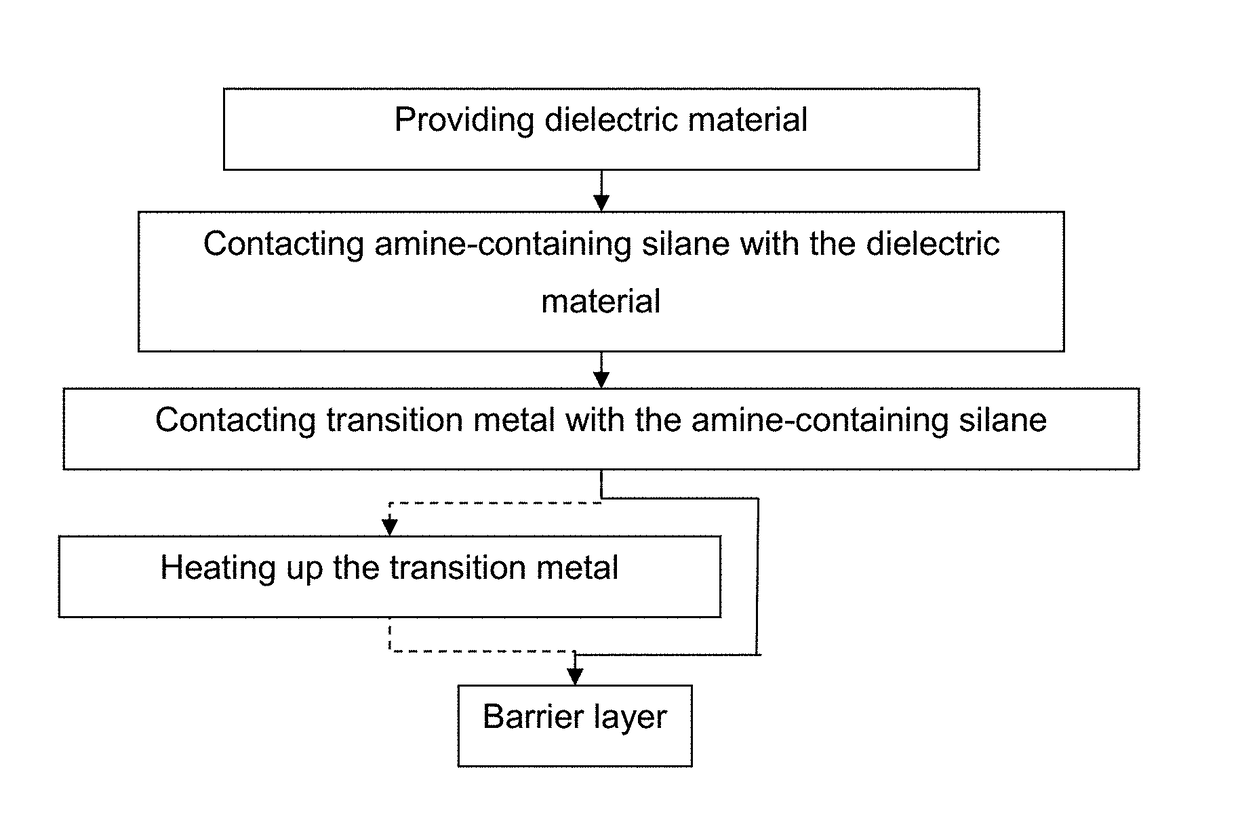Formation of a transition metal nitride
a transition metal and nitride technology, applied in the direction of coatings, basic electric elements, chemical vapor deposition coatings, etc., can solve the problems of increased copper resistivity, loss of barrier properties, and increased copper resistan
- Summary
- Abstract
- Description
- Claims
- Application Information
AI Technical Summary
Benefits of technology
Problems solved by technology
Method used
Image
Examples
example 1
of a Manganese Nitride Barrier Layer for Use in a Damascene Process
[0083]A plasma-enhanced chemical vapour deposited (PECVD) substrate was provided having a layer of porous silicon-based low-k material thereon. The porous silicon-based low-k material had a dielectric constant of 2.4. A pattern of trenches was defined in the layer of low-k material. The exposed surfaces, such as the side walls of the trenches, were then made more hydrophilic by a 2 to 3 s exposure to a CO2 plasma. A SAM of DETA was formed, either from the liquid phase or from the vapour phase, on the side walls of the trenches, at least partially sealing the pores of the porous low-k material. Subsequently, manganese (example 1a) or manganese nitride (example 1 b) was deposited on the SAM using chemical vapour deposition and a 200-400° C. thermal annealing was performed to complete the reaction of the manganese with the SAM; thereby forming a manganese barrier layer comprising manganese nitride. Finally, copper was d...
example 2
of a Ruthenium Nitride Barrier Layer for Use in a Damascene Process
[0087]A substrate was provided having a layer of porous organosilicate low-k material thereon. In one case, the low-k material had a dielectric constant of 2.4; in another, the dielectric constant was 2.55. A pattern of trenches and vias was defined in the layer of low-k material. The exposed surfaces, such as the side walls of the trenches, were then made more hydrophilic by a 2 to 3 s exposure to a CO2 plasma. A SAM of DETA was formed, from the vapour phase, on the side walls of the trenches, at least partially sealing the pores of the porous low-k material. Subsequently, a 20-25 nm thick layer of ruthenium was deposited on the SAM using atomic layer deposition and a 200-400° C. thermal annealing was performed to complete the reaction of the ruthenium with the SAM. Finally, copper was deposited inside the trenches covered with the ruthenium barrier layer. This deposition was performed by means of a (dual) damascene...
PUM
| Property | Measurement | Unit |
|---|---|---|
| temperature | aaaaa | aaaaa |
| temperature | aaaaa | aaaaa |
| thickness | aaaaa | aaaaa |
Abstract
Description
Claims
Application Information
 Login to View More
Login to View More - R&D
- Intellectual Property
- Life Sciences
- Materials
- Tech Scout
- Unparalleled Data Quality
- Higher Quality Content
- 60% Fewer Hallucinations
Browse by: Latest US Patents, China's latest patents, Technical Efficacy Thesaurus, Application Domain, Technology Topic, Popular Technical Reports.
© 2025 PatSnap. All rights reserved.Legal|Privacy policy|Modern Slavery Act Transparency Statement|Sitemap|About US| Contact US: help@patsnap.com



